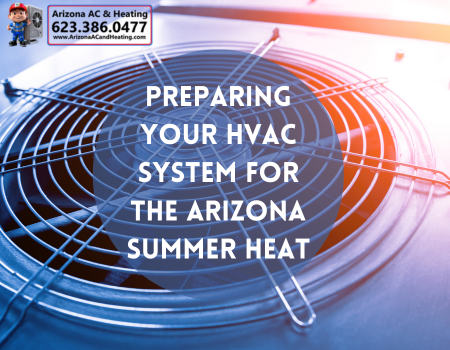Arizona summers are known for their extreme temperatures, often exceeding 100°F for extended periods. During these months, your HVAC (Heating, Ventilation, and Air Conditioning) system works harder than ever to keep your home cool and comfortable. To ensure it runs efficiently and reliably, it’s essential to prepare it before the peak heat arrives. A well-maintained HVAC system not only improves comfort but also reduces energy costs and prevents costly breakdowns. Here are key steps to get your HVAC system ready for the Arizona summer heat.
 1. Schedule a Professional HVAC Inspection
1. Schedule a Professional HVAC Inspection
Before summer begins, schedule a professional HVAC maintenance check. A certified technician will:
- Inspect and clean essential components.
- Check refrigerant levels.
- Test system performance and efficiency.
- Identify potential issues that may end up costing so much to fix or replace.
Annual professional maintenance helps extend the lifespan of your system and ensures it can handle the intense summer heat.
2. Replace or Clean Air Filters
Dirty or clogged air filters reduce airflow and force your HVAC system to work harder, leading to higher energy bills and potential system failure. Replace or clean your air filters every 1-3 months, especially during summer when dust and allergens are more prevalent. High-efficiency filters (HEPA or MERV-rated) can improve indoor air quality by trapping pollen, dust, and pet dander.
3. Clean and Clear the Outdoor Unit
The outdoor condenser unit plays a crucial role in cooling your home by releasing heat from the refrigerant. To keep it operating efficiently:
- Remove dirt, leaves, and debris from around the unit.
- Trim back plants or bushes at least two feet away from the unit.
- Gently rinse the coils with a hose (avoid high pressure) to remove dirt buildup.
A clean outdoor unit allows for better airflow and heat exchange, improving overall system performance.
4. Check and Seal Ductwork
Leaky or poorly insulated ductwork can waste a significant amount of cooled air, making your HVAC system work harder to maintain desired temperatures. Inspect your ducts for:
- Visible gaps, cracks, or disconnected sections.
- Excess dust or dirt buildup inside the ducts.
- Unusual odors or reduced airflow from vents.
Sealing leaks with duct tape or mastic sealant and adding insulation to exposed ducts can improve efficiency and lower cooling costs.
5. Test Your Thermostat
Your thermostat plays a key role in regulating indoor temperatures efficiently. To optimize cooling:
- Test its accuracy by comparing the displayed temperature to a separate thermometer.
- Upgrade to a programmable or smart thermostat to set cooling schedules based on your routine.
- Set your thermostat to 78°F when you’re home and higher when you’re away to reduce energy use without sacrificing comfort.
6. Check Refrigerant Levels
Low refrigerant levels can prevent your system from cooling effectively, leading to increased energy usage and strain on the compressor. Signs of low refrigerant include:
- Warm air blowing from vents.
- Ice buildup on refrigerant lines.
- Hissing or bubbling sounds near the outdoor unit.
If you notice these issues, contact a professional technician to check for leaks and recharge the refrigerant as needed.
7. Improve Home Insulation and Ventilation
Reducing heat gain inside your home can help your HVAC system work more efficiently. Consider these strategies:
- Use blackout curtains or blinds to block direct sunlight.
- Use caulk or weather stripping to seal gaps around doors and windows.
- Use ceiling fans to circulate cool air, allowing you to set the thermostat slightly higher.
- Ventilate attics and crawl spaces to prevent heat buildup.
8. Consider an HVAC Upgrade
If your HVAC system is more than 10-15 years old, upgrading to a newer, energy-efficient model may be a smart investment. Newer units offer:
- Higher SEER (Seasonal Energy Efficiency Ratio) ratings for improved efficiency.
- Variable-speed compressors for better cooling performance.
- Smart technology for remote control and energy savings.
Replacing an aging unit before summer starts can prevent unexpected failures during peak heat.
9. Plan for Emergency Situations
Even with proper maintenance, unexpected breakdowns can happen. Prepare by:
- Knowing the contact information of a reliable HVAC technician.
- Having backup cooling solutions, such as portable fans or a window AC unit.
- Staying hydrated and keeping blinds closed to reduce indoor heat buildup in case of system failure.
Preparing your HVAC system for the Arizona summer heat ensures comfort, reduces energy costs, and extends the lifespan of your unit. Regular maintenance, filter replacements, thermostat adjustments, and duct sealing all contribute to efficient operation. If your system shows signs of wear or inefficiency, consider an upgrade before temperatures soar.

